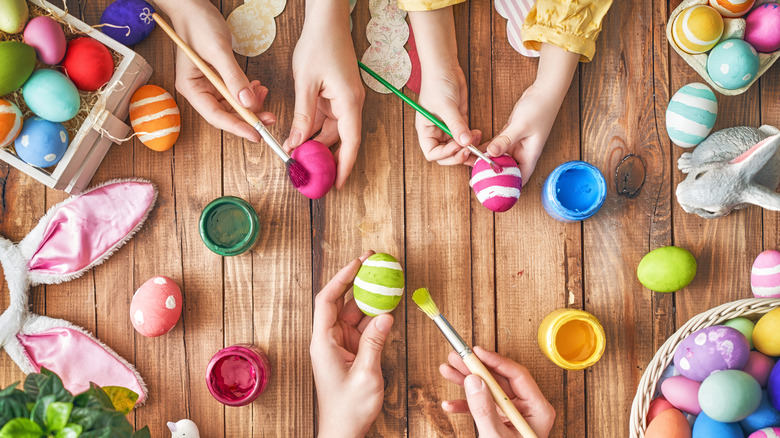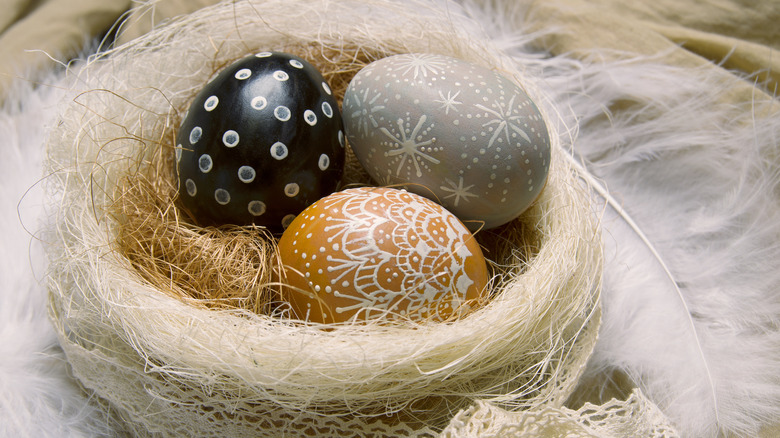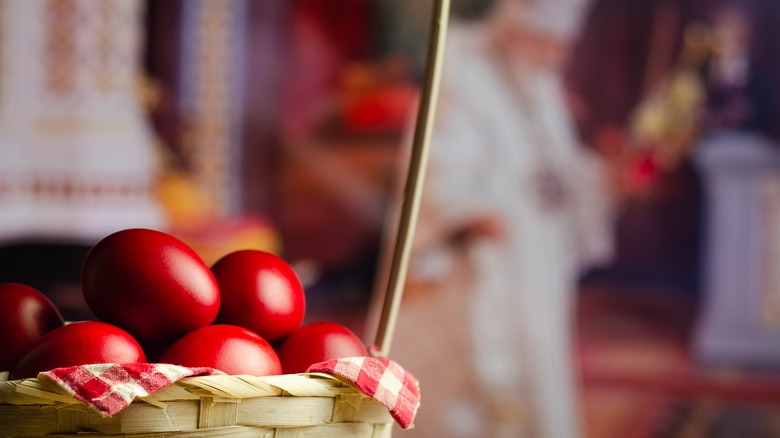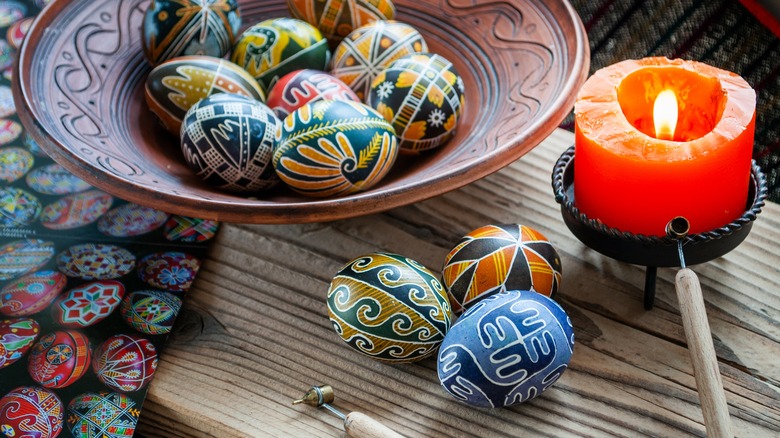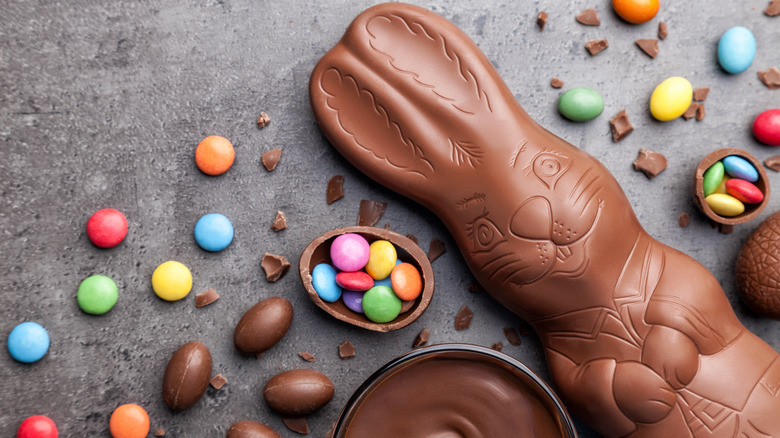The Secret Origins Of Decorating Easter Eggs
As much fun as we have year-round eating eggs in all sorts of ways, it can be particularly fun to decorate them for Easter. Among other culinary traditions, such as Easter ham and Easter lamb, the dyeing and painting of eggs is widely associated with this Christian holiday. On top of that, many families celebrate by hunting for eggs or even rolling them across their lawn.
Of course, Easter dinner itself often features eggs in the multiple scrumptious springtime recipes on its table. There are also plenty of egg-themed candies popular throughout spring, including chocolate-covered marshmallow eggs and Reese's Peanut Butter Eggs, as well as Cadbury Mini Eggs, Crème Eggs, and Caramel Eggs.
Why do we associate eggs with Easter at all, though — and why do we decorate them? This isn't merely some modern, localized trend. It's a time-honored, international tradition with connections to more religions than simply Christianity.
Do Easter eggs have pagan roots?
The extent to which non-Christian religions influenced Easter eggs is a bit hazy, because the further back in time we look, the less clear history becomes. Generally speaking, eggs are natural symbols of birth and renewal because they contain new life. So, there has long been a trend at springtime festivals of people gifting each other eggs. Paganism — loosely speaking, non-Abrahamic religions in the Old World — is one such spiritual tradition that's thought to have held this belief and revered eggs in spring.
As a result, pagans are often credited with kickstarting the Easter egg tradition. Specifically, the Anglo-Saxon celebration of a goddess sometimes known as "Eostre," held at the onset of springtime, is supposedly responsible. During the festival, folks would apparently bury or eat eggs to foster fertility. Christian missionaries reportedly co-opted this holiday's date and customs to make their beliefs more palatable to pagans. In this way, eggs transitioned from generally representing the renewal of earth's life cycle to specifically symbolizing Christ's resurrection.
There are those who doubt this cultural narrative, though. The Guardian, for one, points out that Victorian anthropologists were known to over-credit pagans for inspiring Christian practices. Such claims can sometimes lead to popular misconceptions about what's truly Christian and what's actually pagan, from a scholarly point of view.
What's the Christian significance of Easter eggs?
The Bible may not mention eggs in reference to Easter, but there are still links between the two. As far back as the early days of Christianity, followers living in the historical region of Mesopotamia dyed their eggs for Eastertime. Originally, those eggs were colored red, resembling Christ's blood from the crucifixion, and it's thought that the shell of an egg, which easily cracks, represented Christ's reopened tomb.
It's become customary for Christians to fast during Lent, and eggs were off the menu during that period circa 13th-century Europe. Because Easter falls at the end of Lent, it marked when Christians could resume eating eggs, and the association between the two deepened. Some folks hard-boiled their eggs, so they could safely store them during Lent before distributing them to those less fortunate come Easter. Decorating eggs was a clever way to keep track of which ones were laid during Holy Week (the week preceding Easter); legends hold that such eggs bolster vitality and promise wealth.
Sometimes, English villagers would gift such eggs to their churches or lords. There's also the extravagant story of King Edward I, who dyed and gilded hundreds of eggs before giving them away for the royal Easter entourage of 1290. Much later on, in the 19th century, the Victorians started giving colorful eggs to children to provide them with colorful, meaningful fun. During the 20th century, the working class began to follow suit, and the rest is history.
Easter eggs are widely popular
All the way from Mesopotamia to England and beyond, Easter eggs are beloved.
For example, some Ukrainians create a special kind of egg known as pysanky, which is painstakingly adorned with hot wax and inedible dye. The mythology behind these objects varies, but they predate Christianity's introduction to the area. Initially, they instead represented the pagan idea that eggs are inherently powerful. Some think pysanky honor the dead, while others think they can stave off an untimely demise or even the apocalypse itself. Eventually, the Christian co-opting of this belief occurred, and pysanky's triangular patterns came to symbolize the holy trinity with Christ included.
Equally complex is the mythology of the Easter bunny. Like eggs, rabbits have long represented fertility (for obvious reasons). German folklore features an egg-laying hare known as "Osterhase," and German children traditionally made nests for the hare to lay their colorful eggs in. This tradition was later adopted by much of Western society, but nests have become baskets and colorful eggs have become all sorts of candies.
Some claim the pagans are specifically to thank for this bit of folklore. Supposedly, the old-German springtime goddess, Eostre, kept Osterhase as her animal companion. The Guardian, however, claims that this oft-repeated factoid is actually fiction. Historical proof for the worship of Eostre is shaky, especially in relation to her hare. Better documented is the introduction of Osterhase to German literature in the 1500s as a Santa-like figure who gave eggs to well-behaved children.
Why (and how) do we still decorate Easter eggs?
Mythology aside, most would agree Easter eggs are, at least, tasty. We have Europe to thank for creating the first chocolate egg during the 1800s, which began a whole eggy candy craze. Two confectionery developments from the 19th century (cocoa butter and pure cocoa) made it possible for Cadbury to popularize this treat. Then, Cadbury's 1905 Dairy Milk Chocolate sealed the deal for eggy candy's ubiquity. It's plain to see why this form of Easter egg persists. It's delicious — and it makes candy companies tons of money.
Why do we still decorate actual eggs, though? It's not for culinary reasons, and few do it to directly symbolize their religious beliefs. Well, frankly, it's fun. Dyeing eggs is a family-friendly activity, and staging an Easter egg hunt for kids is reliably delightful. The same goes for rolling Easter eggs across the lawn (which may symbolize the stone rolling away from Christ's tomb); that entertainment value is why the White House has hosted its Easter Egg Roll since 1878.
The real question is, how do we decorate Easter eggs? There are many methods, but here's one: Purchase eggs a week ahead of time and refrigerate them so they easily peel once cooked. Then, mix food coloring with boiling water and vinegar in a heat-resistant container, dunk hardboiled eggs in the mixture for a handful of minutes, and take them out to dry. Hide them, roll them, or peel them to your heart's content.
